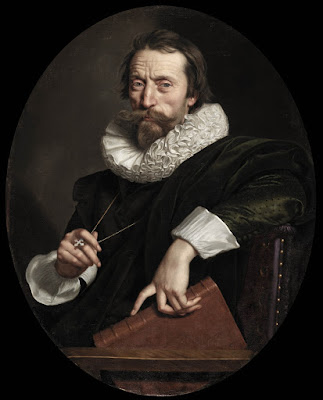 |
| Adam Bernaert Vanitas Still-Life ca. 1665 oil on panel Walters Art Museum, Baltimore |
 |
| Simone Cantarini (il Pesarese) Sibyl Reading ca. 1630-35 oil on canvas Banca Popolare dell' Adriatico, Pesaro |
 |
| Jan Lievens Portrait of Anna Maria van Schurman 1649 oil on canvas National Gallery, London |
 |
| Diego Velázquez Portrait of Court Buffoon called El Primo ca. 1636-38 oil on canvas Museo del Prado, Madrid |
 |
| Thomas Wyck Scholar in his Study before 1677 oil on canvas Hallwyl Museum, Stockholm |
 |
| David Teniers the Younger The Alchemist ca. 1652 oil on panel Royal Collection, Great Britain |
 |
| attributed to Pierfrancesco Cittadini Portrait of a Lady holding a Book before 1681 oil on canvas Bowes Museum, Barnard Castle, County Durham |
 |
| Frans Pourbus the Younger Portrait of Giovanni Battista Marino ca. 1621 oil on canvas Detroit Institute of Arts |
 |
| Jusepe de Ribera Crates 1636 oil on canvas National Museum of Western Art, Tokyo |
 |
| Simon Vouet Portrait of a Young Woman ca. 1620-21 oil on canvas Pinacoteca di Brera, Milan |
 |
| Carlo Dolci Portrait of Sir Thomas Baines ca. 1665-70 oil on canvas Fitzwilliam Museum, Cambridge |
 |
| Giovanni Serodine Portrait of the Artist's Father 1628 oil on canvas Museo Cantonale d'Arte, Lugano, Switzerland |
 |
| Frans Hals Portrait of an Elderly Lady 1633 oil on canvas National Gallery of Art, Washington DC |
 |
| Willem van der Vliet An Allegory 1627 oil on canvas private collection |
 |
| Pieter Codde Young Man Smoking and Ignoring his Studies ca. 1630-33 oil on panel Palais des Beaux-Arts de Lille |
"What can we expect when we vie with one another every day in admitting to degrees any and every impecunious student drawn from the dregs of the people who applies for one? They need only to have learnt by heart one or two definitions and distinctions, and to have spent the usual number of years in chopping logic – it matters not what progress they have made or of what character they are; they can be idiots, wasters, idlers, gamesters, boon companions, utterly worthless and abandoned, squanderers and profligates; let them only have spent so many years at the university in the capacity, real or supposed, of gownsmen, and they will find those who for the sake of profit or friendship will get them presented, and, what is more, in many cases with splendid testimonials to their character and learning. These they procure on leaving from persons who unquestionably jeopardize their own reputation by writing them. For (as one saith) doctors and professors think of nothing save how from their various professions, and especially those which are irregular, they may further their own advantage, and benefit themselves at the expense of the State. Our annual university heads as a rule pray only for the greatest possible number of freshmen to squeeze money from and do not care whether they are educated or not, provided they are sleek, well groomed, and good-looking, and in one word, men of means. Philophasters innocent of the arts become Masters of Arts, and those are made wise by order who are endowed with no wisdom, and have no qualifications for a degree save a desire for it. Theologasters, if they can but pay, have enough learning and to spare, and proceed to the very highest degrees. Hence it comes that such a pack of vile buffoons, ignoramuses wandering in the twilight of learning, ghosts of clergymen, itinerant quacks, dolts, clods, asses, mere cattle, intrude with unwashed feet upon the sacred precincts of Theology, bringing with them nothing save brazen impudence, and some hackneyed quillets and scholastic trifles not good enough for a crowd at a street corner. This is that base and starveling class, needy, vagabond, slaves of their bellies, worthy to be sent back to the plough-tail, fitter for the pigsty than the altar, which has basely prostituted the study of divinity."
– Robert Burton, from The Anatomy of Melancholy (1621)